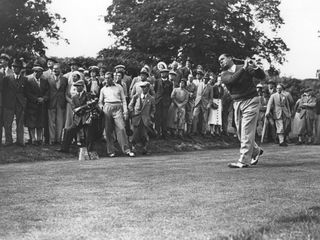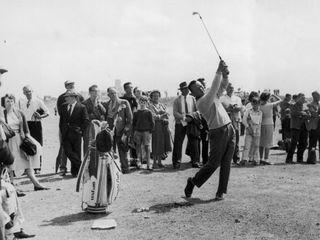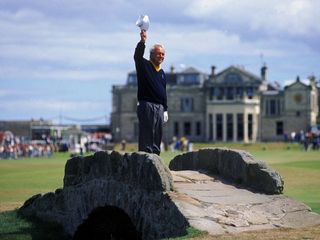Game Changers: The Haig & The King
Walter Hagen and Arnold Palmer changed professional golf in the 20th Century


Here we take a look at two players who did more than any others to change the golfing landscape for professional players during the 20th Century – Walter Hagen and Arnold Palmer.
Walter Hagen Date: June 27 1933Location: Southport & Ainsdale, Lancashire

“I never wanted to be a millionaire, I just wanted to live like one.” Walter Hagen’s flamboyant approach to life brought him levels of fame and wealth previously unheard of for professional golfers.
Champagne and limousines, parties in the Savoy, golfing with the Prince of Wales: Hagen was a showman on and off the course. But he backed up his bravado with a sparkling game. He won 11 Major titles and 45 PGA Tour events between 1914 and 1936.
Beginning his career at a time when pro golfers were treated as second-class citizens, particularly in the UK, he did a huge amount to improve their position. When Hagen first travelled to Britain for the 1920 Open at Royal Cinque Ports he was astonished not to be allowed into the clubhouse. To make a point “The Haig” had his chauffeur park his Daimler directly outside the front door and he changed his shoes there. Gene Sarazen said of Hagen, “All professionals should say a silent thanks to Walter Hagen each time they stretch a cheque between their fingers.”
This picture shows Hagen competing in the Ryder Cup of 1933 (with the Prince of Wales looking on.) The American had a superb record in the trans-Atlantic matches. Hagen captained the US side in each of the first six competitions (1927-1937). As a player, in the first five, his results read: 7 wins, 1 half and only 1 defeat.
Arnold Palmer Date: July 13, 1961 Location: Royal Birkdale, Lancasahire
Get the Golf Monthly Newsletter
Subscribe to the Golf Monthly newsletter to stay up to date with all the latest tour news, equipment news, reviews, head-to-heads and buyer’s guides from our team of experienced experts.

In order to thrive, a sport needs a figurehead. Enigmatic characters like Muhammad Ali, Carl Lewis and Tiger Woods have captured the public’s imagination and caused the popularity of their respective sports to soar. In the mid 1950s golf’s premier star Ben Hogan was on the wane and, as the “television age” began, the sport was in desperate need of a new talisman. Enter Arnold Palmer. A relatively late developer, he was 28 when he blazed into the public eye at the 1958 Masters. Displaying a cavalier approach, later to become his trademark, Arnie birdied the last two holes to sneak past Doug Ford and Jack Hawkins by a single shot.
Developing a reputation for swashbuckling and attacking golf, “The King” gained an army of fans who cheered him on to six further Major Championships and 62 PGA Tour victories. He was golf’s first global superstar and the sport would not be where it is today without him.
Palmer’s back to back Open wins in 1961 and 62 did a great deal to encourage pros from the US to travel to the UK to compete for golf’s greatest championship and his charisma and good humour won him many supporters this side of the Atlantic. In this picture a group of interested spectators watch Arnie blasting balls away on the practice ground, prior to the 1961 Open at Birkdale.
In 1995 Palmer bid an emotional farewell to The Open. The image of Arnie waving goodbye from the top of St Andrew’s Swilken Bridge is etched on the memory of golf fans across the globe.


Fergus is Golf Monthly's resident expert on the history of the game and has written extensively on that subject. He is a golf obsessive and 1-handicapper. Growing up in the North East of Scotland, golf runs through his veins and his passion for the sport was bolstered during his time at St Andrews university studying history. He went on to earn a post graduate diploma from the London School of Journalism. Fergus has worked for Golf Monthly since 2004 and has written two books on the game; "Great Golf Debates" together with Jezz Ellwood of Golf Monthly and the history section of "The Ultimate Golf Book" together with Neil Tappin , also of Golf Monthly.
Fergus once shanked a ball from just over Granny Clark's Wynd on the 18th of the Old Course that struck the St Andrews Golf Club and rebounded into the Valley of Sin, from where he saved par. Who says there's no golfing god?
-
 'Gator Netting Is In Place' - Chevron Championship Venue Prepared For 'Safe' Winner's Jump
'Gator Netting Is In Place' - Chevron Championship Venue Prepared For 'Safe' Winner's JumpA tradition which began at the tournament's previous home could continue this year - if the champion is feeling brave enough...
By Jonny Leighfield Published
-
 New Balance 997 SL Golf Shoe Review
New Balance 997 SL Golf Shoe ReviewNew Balance produce some extremely stylish footwear and, in this review, Matt Cradock takes their spikeless 997 SL onto the course
By Matt Cradock Published